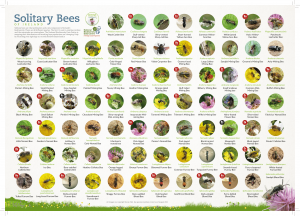The National Biodiversity Data Centre is delighted to release a new free resource: a poster of Ireland’s solitary bees. This new poster aims to raise awareness of this important but often overlooked group of bees, who are vitally important to pollination.
What is a solitary bee?
There are currently 80 different types of solitary bee in Ireland. They do not form large colonies like bumblebees and honeybees, with a queen, workers and males. Instead, they nest alone.
Male and female adults normally emerge from hibernation in spring. The female finds a mate and makes a nest, within which she constructs a small number of little cells. In each cell she lays an egg and leaves a ball of food made of a mixture of pollen and nectar. Once she’s done, she will close the entire nest. With the job complete, she and the males die.
The larvae feed on the provisioned food before pupating and spending the winter hibernating, each dining and sleeping in its own single chamber. They emerge the following spring as adults, when they try to find a mate and the cycle begins again.
Most solitary bees nest in the ground
Around 80% of solitary bees in Ireland are ‘mining’ bees – they create nests by burrowing into areas of bare earth. 20% are ‘cavity-nesting bees’ – they make nests in hollow dead wood, hollow stems or crevices in loose masonry. The bee boxes/hotels you can make or buy provide homes for these cavity-nesting species.
In the summer, it is amazing watching solitary bees, like the cavity-nesting leaf cutter bees. They come and go from their nests, carrying back pieces of leaf or petal to line the cells, and then to ‘plug’ the nest entrance when they are done.
Solitary bees are the best pollinators
Solitary bees are vitally important to pollination. Bumblebees and honey bees have evolved to carry a compact pollen pellet on their back legs, allowing them to efficiently bring as much pollen as possible back to feed their larvae. Solitary bees don’t do this. Instead, some solitary bees carry a loose pollen pellet on their hind legs, and others pack pollen into the hairy underside of their abdomen. In both cases, in trying to collect pollen to bring back to their nest, they widely scatter it between flowers. For this reason, one solitary bee female can often be a more effective pollinator than a female bumblebee or honey bee.
You can download the new solitary bee poster for free here, or from the resources page of the All-Ireland Pollinator Plan website.
Find out more:

